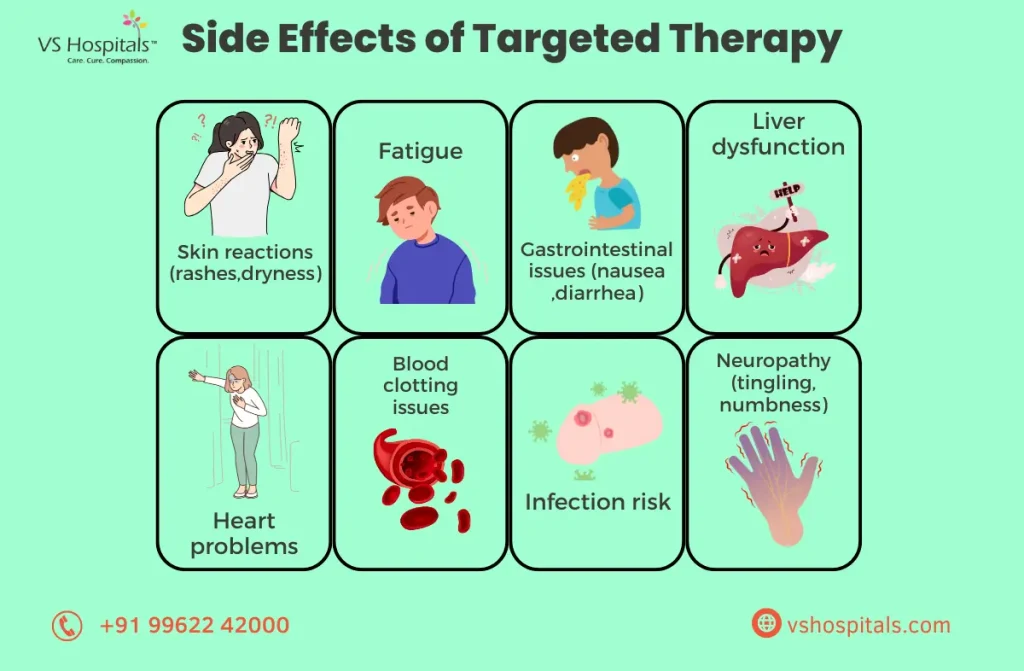Targeted therapy for cancer has been a game-changer in the fight against this complex disease. Unlike conventional cancer treatments such as chemotherapy and radiation, targeted therapy works by honing in on the specific molecules that cause cancer cells to grow and spread. This precision treatment allows doctors to attack cancer cells directly while minimizing harm to healthy tissues.
In this blog post, we’ll delve into what targeted therapy for cancer entails, its different types, who can benefit from it, and how it differs from chemotherapy. We’ll also explore its benefits, drawbacks, and potential side effects to help you understand whether this innovative approach might be the right treatment option for you.
What is Targeted Therapy?
Targeted therapy for cancer is a type of cancer treatment that focuses on targeting specific proteins or genes that help cancer cells grow and survive. Traditional cancer treatments like chemotherapy or radiation affect both healthy and cancerous cells, often leading to unpleasant side effects. In contrast, targeted therapy is more selective, attacking cancer cells based on their unique characteristics.
For instance, cancer cells often develop abnormal proteins or gene mutations that allow them to grow uncontrollably. Targeted therapy identifies these abnormalities and intervenes in the cancer’s growth process. This makes it a more personalized approach to treatment compared to chemotherapy.

Types of Targeted Therapy
There are two primary types of targeted therapies:
- Small Molecule Drugs: These are drugs that can enter cells and interfere with the internal processes that cancer cells use to grow. These drugs target proteins within cancer cells and block the signals they send to reproduce uncontrollably. Examples include tyrosine kinase inhibitors, often used in targeted therapy for lung cancer.
- Monoclonal Antibodies: These are lab-engineered antibodies designed to recognize specific proteins on the surface of cancer cells. Once attached, they can directly destroy cancer cells or mark them for attack by the immune system. Monoclonal antibodies are commonly used in targeted therapy for breast cancer to block HER2, a protein that helps cancer cells grow.
Who is Treated with Targeted Therapy?
Targeted therapy for cancer is used in a variety of cancers, including:
- Lung Cancer: Specific mutations like EGFR, ALK, and ROS1 can be targeted with medications designed to block these mutations.
- Breast Cancer: HER2-positive breast cancer patients often benefit from targeted drugs that block this protein, which promotes cancer cell growth.
- Ovarian Cancer: BRCA gene mutations are often treated with targeted therapies known as PARP inhibitors. These block a protein that helps cancer cells repair themselves, making them more likely to die off.
Patients diagnosed with cancers that have identifiable genetic mutations or abnormal proteins are typically candidates for targeted therapy. Doctors often run genetic tests to determine whether a patient’s cancer cells are suitable for this type of treatment.
How Does Targeted Therapy Work Against Cancer?
Targeted therapy works by disrupting specific molecules or pathways within cancer cells. These therapies can:
- Stop the growth of cancer cells: By blocking the signals that tell cancer cells to divide.
- Trigger cancer cell death: Some targeted therapies damage the DNA within cancer cells, causing them to die.
- Block blood supply to tumors: Some targeted drugs stop the growth of new blood vessels (angiogenesis) that tumors need to survive.
For example, in targeted therapy for lung cancer, specific medications may be used to block mutations like EGFR or ALK, which can lead to improved lung cancer survival rates. Similarly, targeted therapy for breast cancer often focuses on HER2-positive tumors, leading to more personalized and effective treatments.
Are There Drawbacks to Targeted Therapy?
While targeted therapy offers many benefits, it also has some limitations. These include:
- Cancer Resistance: Over time, cancer cells can become resistant to targeted therapy. When this happens, the cancer may stop responding to the treatment, necessitating a different approach.
- Not Suitable for All Cancers: Targeted therapies only work for cancers with identifiable mutations or abnormal proteins. Some cancers do not have these characteristics and cannot be treated with targeted therapy.
- Cost: Targeted therapies can be more expensive than traditional treatments due to the complexity of the drugs and the need for specialized testing to determine suitability.
Despite these drawbacks, targeted therapy for ovarian cancer has shown promise, particularly for patients with BRCA mutations, as these cancers tend to respond well to PARP inhibitors.
Benefits of Targeted Therapy
The benefits of targeted therapy for cancer are significant, making it an attractive option for many patients:
- Precision Targeting: Because the drugs specifically target cancer cells, they generally cause less damage to healthy cells, leading to fewer side effects.
- Effectiveness in Specific Cancers: For certain cancers, targeted therapies can be more effective than chemotherapy. For example, targeted therapy for lung cancer survival rates has improved outcomes for patients with specific gene mutations.
- Fewer Side Effects: Patients undergoing targeted therapy may experience fewer side effects compared to those receiving chemotherapy or radiation therapy. While side effects still exist, they are often milder and easier to manage.
Side Effects of Targeted Therapy
Though targeted therapy is generally better tolerated than chemotherapy, it still has side effects. Some common side effects include:
- Skin problems: Rashes or dry skin can occur, particularly with EGFR inhibitors used in targeted therapy for lung cancer.
- Diarrhea: Digestive issues are common with certain types of targeted drugs.
- Fatigue: Patients may experience general fatigue, but this is typically less severe than with chemotherapy.
Side effects will depend on the specific drug used and the patient’s overall health. It’s important to work closely with your healthcare team to manage any side effects during treatment.
What Can I Expect When Having Targeted Therapy?
If you are undergoing targeted therapy for cancer, here’s what you can expect:
- Personalized Treatment Plan: Your treatment plan will be based on the specific genetic characteristics of your cancer.
- Monitoring and Adjustments: Regular check-ups will be needed to track your progress, and your treatment may be adjusted if the cancer develops resistance or if side effects become problematic.
- Outpatient Treatment: Most targeted therapies are administered in outpatient settings, meaning you can continue daily activities while undergoing treatment.
How is Targeted Therapy Different from Chemotherapy?
Targeted therapy and chemotherapy both treat cancer but in very different ways:
- Mechanism: Chemotherapy kills all rapidly dividing cells, including both cancerous and healthy cells, which can cause significant side effects. In contrast, targeted therapy focuses only on cancer cells, leaving most healthy cells unharmed.
- Side Effects: Chemotherapy is known for harsh side effects like hair loss, nausea, and vomiting. targeted therapy for ovarian cancer tends to have milder side effects, making it a more comfortable option for many patients.
- Effectiveness: While chemotherapy is effective for many types of cancer, targeted therapy for cancer can sometimes offer better results in specific cancers, such as targeted therapy for breast cancer or targeted therapy for lung cancer.
Conclusion
Targeted therapy for cancer has emerged as a powerful tool in the fight against cancer, offering a more precise and often less harmful treatment option. By focusing on the unique genetic characteristics of cancer cells, this approach holds the potential for improved outcomes and fewer side effects. If you or a loved one has been diagnosed with cancer, discussing targeted therapy with your healthcare provider could help you find a personalized and effective treatment plan.
